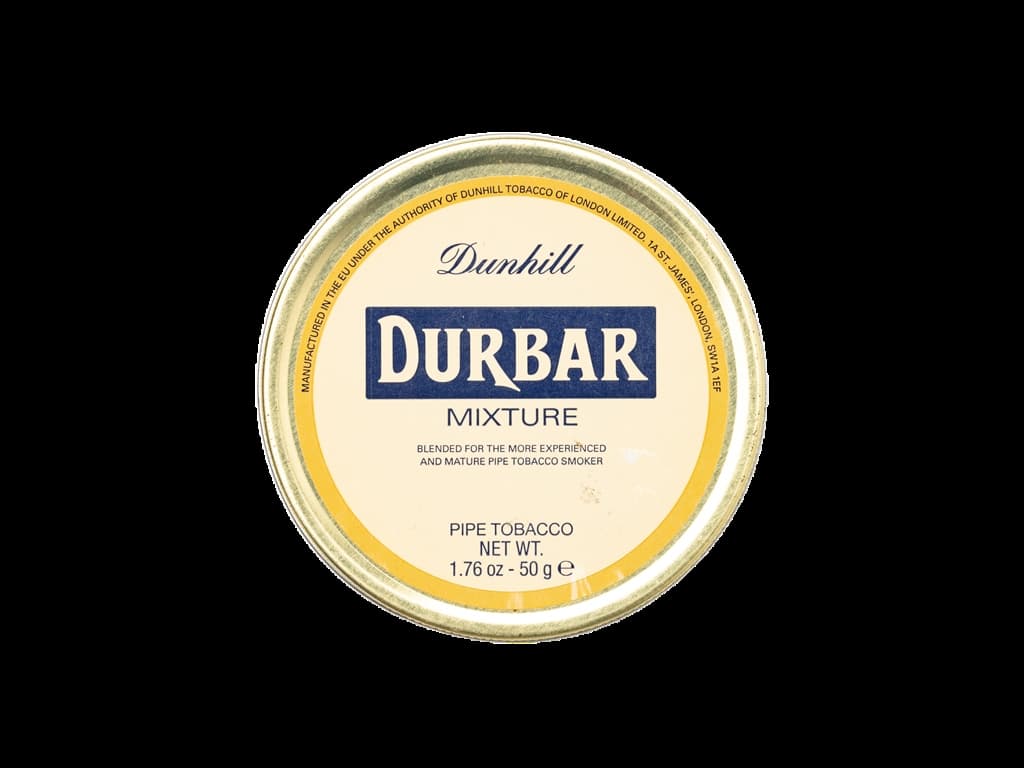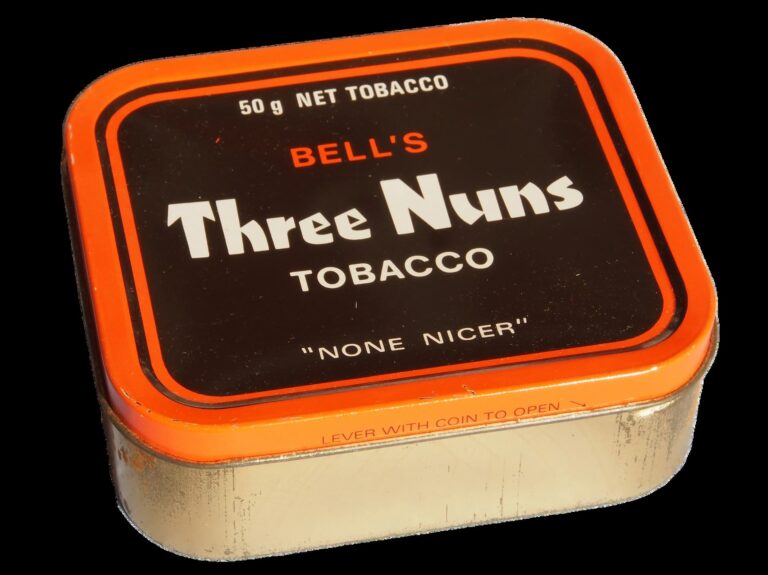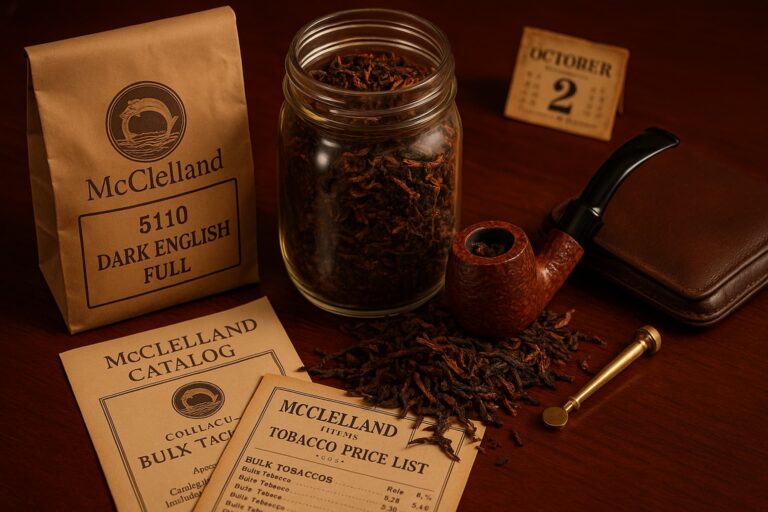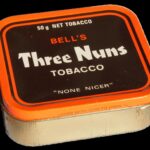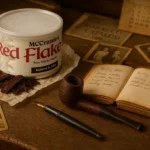The Duke Street Legend: Dunhill Durbar – An Aged Oriental Masterpiece from 1910
There are certain moments in a pipe smoker’s journey that feel like archaeological discoveries, and opening this aged tin of Dunhill Durbar is undoubtedly one of them. As I carefully pry off the lid of this 2002 Murray’s production tin that has been quietly aging in my cellar for over two decades, I’m overwhelmed by the profound significance of what I’m about to experience. This isn’t just any tobacco—this is a piece of Dunhill’s most prestigious heritage, a blend that traces its lineage back to 1910 when Alfred Dunhill first introduced it alongside Royal Yacht as one of his foundational creations. The name “Durbar,” referring to the grand ceremonial courts of British India, perfectly captures the regal character of this Oriental-forward masterpiece that was designed for the most experienced and discerning pipe smokers. Tonight, as I prepare to smoke this irreplaceable relic from the final era of authentic Dunhill production under Murray’s stewardship, I’m not just enjoying a pipe—I’m communing with over a century of tobacco artistry and experiencing a blend that represents the pinnacle of Oriental tobacco mastery.
A Glimpse into History: The Birth of a Legend
To truly appreciate Dunhill Durbar, one must first understand the remarkable circumstances of its creation and the visionary mind behind its conception. In 1910, Alfred Dunhill was already establishing himself as London’s premier tobacconist, having opened his Duke Street shop just three years earlier. The tobacco industry was experiencing a renaissance of innovation, and Dunhill was at the forefront of this movement, determined to create blends that would challenge conventional wisdom and elevate pipe smoking to new heights of sophistication.
The introduction of Durbar alongside Royal Yacht marked a pivotal moment in Dunhill’s evolution from a simple tobacco retailer to a creator of legendary blends. While many tobacconists of the era were content to offer generic mixtures or simple Virginia blends, Dunhill had grander ambitions. He understood that the discerning smokers of London’s elite circles demanded something more sophisticated, more complex, and more challenging than the standard fare available elsewhere.
The choice of the name “Durbar” was particularly inspired, reflecting both the exotic character of the blend and the imperial grandeur that defined the Edwardian era. A durbar was a ceremonial court held by Indian princes and later by British colonial administrators, representing the height of pomp, circumstance, and cultural sophistication. The name suggested that this tobacco was not for the casual smoker but for those who appreciated the finer things in life, who understood that true luxury lay not in ostentation but in subtle perfection.
From its inception, Durbar was designed as an Oriental-forward blend, a bold choice that set it apart from the Virginia-dominated mixtures that were popular at the time. Dunhill understood that Oriental tobaccos, with their complex spice profiles and exotic character, could provide a smoking experience unlike anything else available. However, creating a successful Oriental-forward blend required exceptional skill and understanding of tobacco behavior, as Oriental leaf could easily become overwhelming or unbalanced when not properly integrated with complementary tobaccos.
The original Durbar formula featured a high proportion of Oriental leaf, carefully balanced with Virginia tobaccos for sweetness and body, and enhanced with a touch of Latakia for depth and complexity. The blend was processed using Dunhill’s signature broad cut, which allowed for slow, even burning and maximum flavor development. This wasn’t a blend created for mass appeal—it was crafted for the connoisseur who appreciated subtlety, complexity, and the kind of quality that could only be achieved through decades of experience and an uncompromising commitment to excellence.
Throughout its long history, Durbar maintained its reputation as one of Dunhill’s most sophisticated offerings. The blend was particularly popular among experienced smokers who had developed their palates sufficiently to appreciate its nuanced character. It became a benchmark for Oriental-forward blends, influencing countless other tobacconists and establishing a template that would be emulated but never truly replicated.
The transition from Dunhill’s original production to Murray’s stewardship in the latter part of the 20th century marked both a continuation and an evolution of the Durbar legacy. Murray’s, with their deep understanding of traditional British blending techniques, maintained the essential character of Durbar while adapting it to changing tobacco availability and processing methods. The Murray’s era Durbar, which this aged tin represents, is widely considered to be the finest iteration of the blend, capturing all the complexity and sophistication of the original while benefiting from decades of refinement and perfection.
The Aged Revelation: Tin Note & Appearance
The moment I break the seal on this two-decade-old tin of Murray’s Durbar, I’m immediately transported to a different world—one where tobacco blending was approached with the same reverence and skill as fine wine making, where every element was carefully considered and perfectly balanced to create something truly extraordinary. The pop of the lid releasing creates an almost sacred atmosphere, and what emerges is an aromatic experience that has been transformed by years of patient aging into something approaching perfection.
The tin note that greets me is a masterclass in Oriental tobacco artistry that could only have been achieved through the combination of exceptional original blending and the transformative power of time. The first impression is unmistakably Oriental—but not the sharp, sometimes aggressive character that fresh Oriental tobacco can display. This is Oriental tobacco that has learned patience, that has mellowed and integrated over the decades into something far more sophisticated and refined. There’s an immediate richness that speaks to the quality of the leaf selection, a depth that suggests layers upon layers of complexity waiting to be discovered.
The Oriental character presents itself as a warm, exotic spiciness that carries hints of ancient bazaars and distant trade routes. There are notes of cardamom and cinnamon, but also subtler suggestions of nutmeg and cloves that speak to the diverse origins of the Oriental leaf used in this blend. This isn’t the simple spiciness of artificially flavored tobacco—it’s the natural complexity that comes from properly aged Oriental leaf, where the various regional characteristics have learned to work together rather than competing for attention.
Beneath this Oriental foundation, the Virginia component reveals itself with remarkable subtlety and grace. The Virginia tobaccos have evolved far beyond their original bright character, developing rich notes of caramelized sugar and dried fruits that provide a perfect counterpoint to the Oriental spice. There are hints of figs and dates, but also deeper notes of brown sugar and molasses that speak to the natural sugars that have concentrated during the aging process. This Virginia character doesn’t dominate—instead, it provides a sweet, honeyed foundation that allows the Oriental tobaccos to shine while preventing them from becoming overwhelming.
The Latakia component, while present in smaller quantities, makes its presence known with characteristic smoky, woody notes that add depth and complexity to the overall bouquet. The Latakia has aged beautifully, losing any harsh edges while retaining its distinctive character. It provides a grounding element that ties the Oriental and Virginia components together, creating a harmony that speaks to the masterful blending that went into this tobacco’s creation.
What strikes me most about this aged tin note is its perfect integration and balance. Where fresh tobacco might present its components as distinct elements competing for attention, this aged Durbar has achieved true harmony. The Oriental, Virginia, and Latakia components have learned to dance together, each enhancing the others without overwhelming or masking their contributions. There’s also a subtle earthiness that speaks to the tobacco’s agricultural origins, a grounding note that adds depth and complexity to the overall experience.
The aging process has also developed what I can only describe as a “vintage” character—a subtle mustiness that isn’t unpleasant but rather adds to the tobacco’s mystique and historical significance. It’s the same quality you might find in a well-aged wine or a rare book, a patina of time that speaks to the tobacco’s journey through the decades. This character is particularly pronounced in the deeper notes, adding a layer of complexity that simply cannot be achieved through any process other than patient aging.
Visually, the tobacco tells the story of its long journey through time. The broad cut that was characteristic of Dunhill’s processing is still evident, though the tobacco has compressed slightly under its own weight over the years. The Oriental tobaccos have taken on a rich, dark brown color that speaks to their maturity and concentration, while the Virginia components have darkened to a beautiful amber hue. The overall effect is of a tobacco that has found its equilibrium, where all the components have learned to work together rather than competing for attention.
The Journey Through the Bowl: An Aged Smoke
Loading this aged Dunhill Durbar into my cherished Peterson Sherlock Holmes Professor—a pipe that seems perfectly suited to such a distinguished and intellectual tobacco—I’m struck by how effortlessly the aged broad cut flows into the chamber. This is tobacco that has learned patience over the decades, settling into the bowl with the grace and confidence that only comes from proper aging. The tactile experience alone tells me I’m about to embark on something extraordinary, a journey through time that will reveal the true artistry of Dunhill’s master blenders.
The initial light reveals the first hints of the transformation that two decades have wrought upon this remarkable blend. Where fresh Oriental-forward blends might announce themselves with bold, sometimes overwhelming flavors, this aged Durbar begins with a gentle, sophisticated introduction. The Oriental character is immediately present but refined, providing a warm, spicy foundation that carries just enough exotic character to remind you of its heritage without overwhelming the palate. This is the mark of truly exceptional aged tobacco: all the elements are still there, but they’ve learned to work in perfect harmony.
As I progress into the first third of the bowl, the true genius of Dunhill’s Oriental-forward philosophy begins to reveal itself. The Oriental tobaccos that form the backbone of this blend have evolved into something truly remarkable—a rich, complex tapestry of flavors that provides both spice and depth without ever becoming harsh or overwhelming. The exotic character is there in abundance—hints of cardamom, nutmeg, and that distinctive smokiness that comes from properly aged Oriental leaf—but it’s all presented with a subtlety and integration that speaks to both the quality of the original blending and the transformative power of time.
The Virginia tobaccos that complement the Oriental base have undergone their own remarkable transformation. Where fresh Virginia can sometimes be sharp or one-dimensional, this aged version reveals layers of complexity that unfold gradually throughout the smoking experience. The natural sweetness has concentrated and caramelized over the decades, creating rich notes of brown sugar, honey, and dried fruits. There’s a particular fig-like character that emerges on the retrohale, a sweetness that’s both natural and sophisticated, never cloying or artificial.
The Latakia component, while present in smaller quantities than in a traditional English blend, makes its presence felt with characteristic smoky, woody notes that add depth and complexity without dominating the Oriental character. The Latakia has aged beautifully, developing a creamy, almost velvety character that provides a perfect counterpoint to the spiciness of the Oriental tobaccos. This isn’t the aggressive, sometimes harsh Latakia that can dominate lesser blends—this is Latakia that has learned its place, providing support and depth while allowing the Oriental character to shine.
What makes this aged Durbar truly exceptional is how all the components have learned to enhance each other rather than compete for attention. The spiciness of the Oriental tobacco provides a perfect foundation for the sweetness of the Virginia, while the Virginia adds body and richness that prevents the Oriental from becoming too intense. The Latakia ties everything together, providing a smoky backdrop that enhances both the Oriental spice and the Virginia sweetness without overwhelming either.
As the bowl progresses into the middle third, additional layers of complexity begin to emerge. The aging process has developed what can only be described as tertiary flavors—subtle notes that weren’t present in the fresh tobacco but have developed through the slow chemical processes that occur during proper cellaring. There’s a gentle earthiness that speaks to the tobacco’s agricultural origins, a leather-like richness that adds depth without heaviness, and occasional hints of what might be described as incense or exotic spices—the patina of age that adds character without overwhelming the primary flavors.
The strength level of this aged Durbar sits comfortably in the medium to full range, substantial enough to satisfy experienced smokers without overwhelming those who prefer more moderate blends. The nicotine content is present and noticeable, providing enough body to make the smoking experience satisfying without creating any unwanted side effects. This makes it an ideal tobacco for contemplative smoking, equally suitable for a quiet evening of reflection or an engaging conversation with fellow pipe enthusiasts who appreciate complexity and sophistication.
The burn characteristics of this aged tobacco are simply exemplary. The broad cut lights easily and burns evenly, requiring minimal attention and very few relights. The tobacco maintains its moisture content perfectly throughout the bowl, never becoming too dry or too wet, and the flavors remain consistent from first light to final puff. This is tobacco that has reached a state of perfect equilibrium, where all the elements work together to create an effortless and deeply satisfying smoking experience.
As the bowl reaches its conclusion, the tobacco continues to deliver flavor and satisfaction right down to the bottom of the chamber. There’s no harsh finish, no bitter dottle, just a gentle fade that leaves the palate satisfied and already anticipating the next bowl. The room note throughout the smoking experience is pleasant and sophisticated—carrying hints of the tobacco’s Oriental spice and Virginia sweetness without becoming overwhelming or offensive to others nearby. This is the mark of truly exceptional tobacco: it provides a complete, satisfying experience that enhances rather than dominates its environment.
The Wisdom of Time: The Aged Advantage
The transformation that two decades have wrought upon this Murray’s Durbar serves as a masterclass in why serious pipe smokers invest so much effort and patience in cellaring exceptional tobacco. What began as an excellent Oriental-forward blend has evolved into something approaching transcendence, demonstrating the remarkable alchemy that occurs when quality tobacco is given the time and proper conditions to reach its absolute potential.
The most dramatic change is in the Oriental component that forms the foundation of this blend. Fresh Oriental tobacco, while prized for its complexity and exotic character, can sometimes be challenging for newer smokers due to its intensity and sometimes sharp edges. Time has mellowed this intensity into something far more sophisticated and approachable. The spiciness that defines Oriental tobacco has evolved from sharp, sometimes aggressive notes into a warm, enveloping presence that enhances rather than dominates the smoking experience. The exotic character is still there—indeed, it’s more pronounced than ever—but it’s presented with a refinement and subtlety that only decades of aging can provide.
The Virginia tobaccos have undergone an equally remarkable transformation. Fresh Virginia, while valued for its natural sweetness and aging potential, can sometimes be sharp or one-dimensional, particularly to newer smokers. Time has mellowed this intensity into something far more complex and nuanced. The bright, sometimes aggressive character of fresh Virginia has evolved into a rich, honeyed sweetness with layers of caramelized sugar, dried fruits, and subtle spices that reveal themselves gradually throughout the smoking experience. The natural sugars in the tobacco have concentrated and developed over the decades, creating depth and complexity that enhances every aspect of the blend.
The Latakia component, while present in smaller quantities, has also benefited enormously from the aging process. Fresh Latakia can sometimes be harsh or overwhelming, particularly in blends where it plays a supporting rather than starring role. Time has mellowed the Latakia into something far more refined and integrated. The smoky, woody character is still there, but it’s been softened and rounded by age, creating a creamy, almost velvety presence that enhances the Oriental and Virginia components without overwhelming them.
Perhaps most importantly, the aging process has enhanced the blend’s overall integration and balance. Fresh Durbar, while excellent, was still recognizable as a blend of distinct components—Oriental here, Virginia there, Latakia providing support. This aged version has achieved true harmony, where all the components work together to create something greater than the sum of its parts. Every element is still identifiable, but they’ve learned to complement and enhance each other rather than competing for attention.
The physical changes in the tobacco are equally significant. The development of natural oils and the concentration of sugars has created a smoking experience that is remarkably smooth and forgiving. The tobacco burns more evenly, requires fewer relights, and maintains its flavor profile more consistently than fresh tobacco typically can. These aren’t just cosmetic improvements—they represent fundamental changes in the tobacco’s structure that enhance every aspect of the smoking experience.
The aging process has also developed what tobacco enthusiasts call “tertiary” flavors—subtle notes that weren’t present in the fresh tobacco but have developed through the slow chemical processes that occur during proper cellaring. These might include gentle earthiness, leather-like richness, or the subtle mustiness that speaks to the tobacco’s journey through time. These flavors add depth and complexity without overwhelming the primary characteristics that made the blend special in the first place.
For those of us fortunate enough to have cellared Murray’s Durbar during its final production years, this aged tobacco represents not just a superior smoking experience, but a connection to a lost era of tobacco craftsmanship. It’s a reminder of what was possible when tobacco blending was approached with the same reverence and skill as any other luxury craft. In a world where so many modern blends feel mass-produced and generic, this aged Durbar stands as a testament to the heights that pipe tobacco can achieve when crafted with vision, skill, and an uncompromising commitment to excellence.
Conclusion: A Legacy Preserved
As I set down my Peterson and reflect on this extraordinary journey through aged Dunhill Durbar, I’m filled with a profound sense of privilege and melancholy. Privilege because I’ve just experienced one of the finest Oriental-forward blends ever created at its absolute peak, aged to perfection and delivering every nuance of flavor that made Dunhill legendary among London’s tobacco connoisseurs. Melancholy because this experience represents something that can never be replicated—when these cellared tins are gone, they’re gone forever, taking with them a piece of tobacco history that exists nowhere else.
This aged Durbar embodies everything that made Dunhill special: the willingness to challenge conventional wisdom, the commitment to quality over commercial considerations, and the understanding that great tobacco requires both exceptional leaf and masterful blending. The decision to create an Oriental-forward blend in 1910 was revolutionary, and the execution was flawless. The result was a tobacco that bridged worlds, appealing to both traditionalists who appreciated quality leaf and adventurous smokers seeking something genuinely new and different.
What makes this aged version so remarkable is how it has evolved beyond even Alfred Dunhill’s original vision. The aging process has taken his masterful blend and refined it further, mellowing any rough edges while enhancing the characteristics that made it special. This is tobacco that has learned patience, that has discovered how to present its various elements in perfect harmony rather than bold contrast. The result is a smoking experience that feels effortless and natural, as if the tobacco knows exactly what it wants to do and does it with complete confidence.
The transition from Dunhill’s original production through Murray’s stewardship and eventually to the modern era represents both continuity and change in the tobacco industry. The Murray’s era Durbar, which this aged tin represents, is widely considered to be the finest iteration of the blend, capturing all the complexity and sophistication of the original while benefiting from decades of refinement and perfection. The subsequent changes in ownership and production methods have resulted in blends that bear the Durbar name but lack the essential character that made the original legendary.
For those who never experienced authentic Durbar during its heyday, reviews like this might seem like exercises in nostalgia or collector fever. But I believe there’s genuine value in documenting these experiences, in preserving the memory of what was possible when tobacco blending was approached with creativity, skill, and vision. Perhaps future blenders will read these words and be inspired to pursue the same level of innovation and excellence that made Dunhill legendary. Perhaps current smokers will be motivated to properly cellar the quality tobaccos that are still available, understanding that time can transform good tobacco into something truly magical.
Dunhill Durbar, particularly in its aged Murray’s form, stands as a monument to the golden age of tobacco innovation. It reminds us that tobacco is capable of extraordinary complexity and beauty when approached with creativity, skill, and respect for the leaf. In an era of mass production and cost-cutting, this aged blend offers a glimpse of what we’ve lost—and what we might achieve again if we’re willing to prioritize vision over profit, character over convenience, and patience over instant gratification.
The legacy of Durbar lives on in every carefully preserved tin, in every reverent review, and in the memories of those who were fortunate enough to experience it. It serves as both a benchmark for excellence and a reminder that the best things in life—whether tobacco, wine, or wisdom—often require time, patience, and vision to reach their full potential. In an age of instant everything, perhaps that’s the most valuable lesson this aged legend has to offer.

